Your past purchasers are your best marketers: build trust with customer review marketing

Businesses are always talking about stimulating word of mouth marketing…
…as if they can fully control the ineffable cycle of personal conversations that lead to recommendations.
The truth is, conversations and community and relationships are not so much created as they are revealed over time. Businesses that seem to have “stimulated word of mouth” are actually effective listeners and curators of conversations their customers are already having.
Customer reviews—a form of user generated content (UGC), in which your audience takes an active, participatory role in your marketing campaigns—are the most obvious output of this listening and curation process.
And they pack a big punch.
In the beauty category in 2022, for example, 76% of Gen Z shoppers said they always read reviews, while 66% of millennial shoppers said the same.
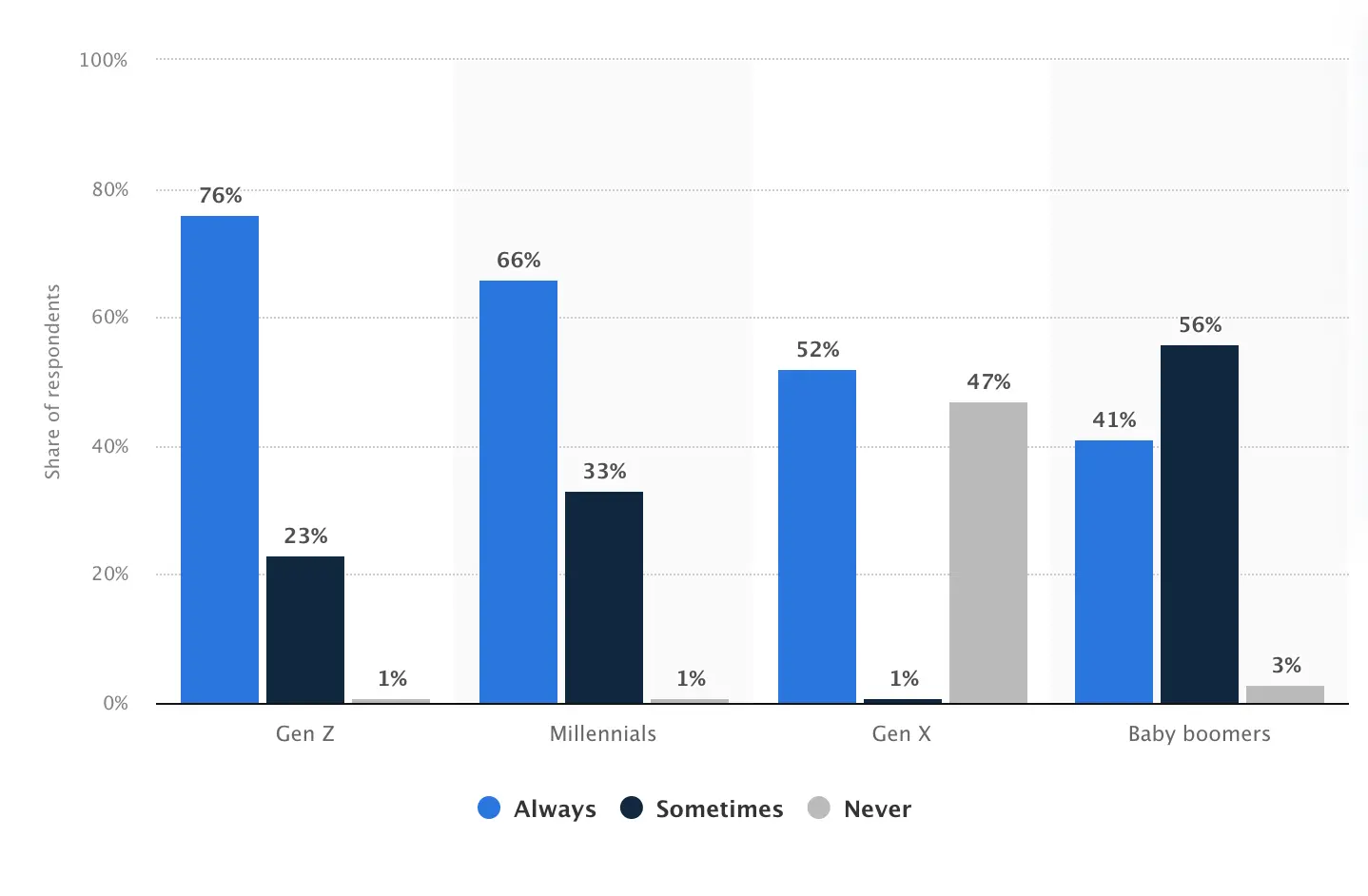
Reviews matter because they’re signals of trust.
But it takes work to fine-tune an effective reviews marketing program. According to Podium, 83% of consumers agree or somewhat agree that reviews need to be relevant and recent to make a difference to their purchasing decisions.
And you can’t work around reviews with high product ratings—from the same survey, 68% of consumers say they won’t trust a high review rating unless it also comes with many product reviews.
Hard work pays off in the long run, here, because collecting customer reviews is a low-cost, high-yield strategy that benefits business margins. As Jordan Brannon, president of Coalition Technologies, points out, UGC like ecommerce reviews “is often more affordable to gather than comparable content is to produce.”
It also increases customer satisfaction. With a solid customer review strategy, “you can gain insight into your products and services and how you can make them better,” says Alexander Melone, co-founder of CodeCrew.
You can gain insight into your products and services and how you can make them better
“The feedback you’ll receive from others in response to promoting a user’s feelings about your product or service will help you understand if their thoughts are unique or if they’re the norm across your user base,” Melone explains.
In other words, when it’s your customers setting expectations for other buyers the result can be fewer product returns—and more sales.
You’ll walk away from this article with a menu of options for collecting customer reviews, and the best ways to show them off once you have them.
4 ways to maximize your marketing efforts with customer reviews
Before you invest time and resources into customer review marketing, it’s important to align your goals with what it can do for your brand.
Your tactics may differ slightly depending on which benefit or outcome you’d like to maximize, so consider these goals before choosing your preferred channels:
1. Improve your brand’s perceived value
Does your brand rely a lot on discounts to acquire new customers? If so, you can start to wean yourself off them with customer reviews.

To increase your brand’s perceived value, your brand needs to, well, be perceived. And since you can’t perceive your own brand with much credibility, the best thing you can do is outsource the job to your satisfied customers. (Real ones, not fake ones—which are easy to spot.)
You create perceived value through social proof. When making decisions, it’s natural for us social creatures to check with each other for signs that those decisions are OK. Reviews “help build trust with new buyers based on the experiences of other customers,” says Lindsay Kolinsky, senior marketing lead at Okendo.
The deeper your well of social proof that demonstrates your product is worth full price, the less you need to rely on discounts as a primary marketing strategy.
2. Increase conversion rates on product pages
Not every review you get will be a glowing one, and that’s OK. While you want your product to delight most of your customers, honest reviews require shades of gray to seem authentic.
“When UGC content is embedded in product description pages and woven into the brand story, it can help support a buying decision within that session—without the shopper leaving the website,” explains Ben Zettler, founder of Zettler Digital.
Why? Unbiased opinions offer real insights about quality, performance, and value. When customers simply know what to expect, they’re more likely to buy. And when they’re satisfied beyond their expectations, they’re more likely to leave a positive and honest review—and the cycle becomes self-perpetuating.
3. Reduce product returns
You can spend a lot of time on your product descriptions and still never describe your product more accurately than your customers.
UGC and customer reviews “help customers relate the product to their own needs when your product photos can’t”—think “That looks good on her body type which is similar to mine,” points out Kathryn Browning, senior marketing manager, Justuno.
It also provides answers to questions about your product that you didn’t even think of having an answer to yet.
It also “provides answers to questions about your product that you didn’t even think of having an answer to yet,” Browning adds.
Detailed customer reviews tell potential buyers how your product meets specific needs and use cases. When buyers understand how well products fit their needs without the sales filter marketers can’t help but use, they make more informed decisions—which translates to fewer product returns on your end.
4. Personalize the customer experience
Customer reviews are clues that deserve your attention. When you collect enough testimonials, language patterns start to stand out—and those patterns can help you refine your value thesis, or the problem you think your product is solving.
Sometimes customer reviews align with your original thesis, and sometimes they don’t. Besides informing your actual product development process, customer reviews are also a valuable tool for learning how to talk to customers in their own “language,” so to speak—which can improve retention rates.
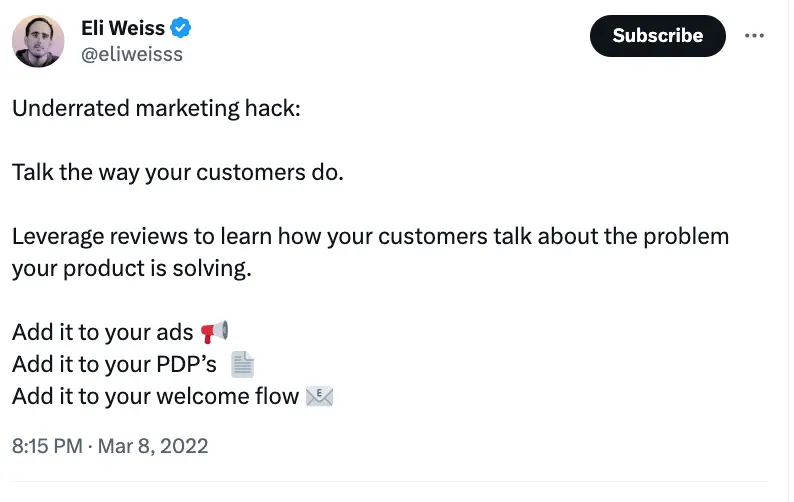
How to use customer reviews across different marketing channels
Once you understand the goal of your online review marketing program, you’re off to the races. But collecting and curating ecommerce reviews is maybe 30% of the work. The rest is how you leverage them, and where.
When brands say they’re “customer obsessed,” what does that actually mean? Besides incorporating customer feedback into the product development process, it also means showcasing their customers on every channel their brand has chosen to invest in.
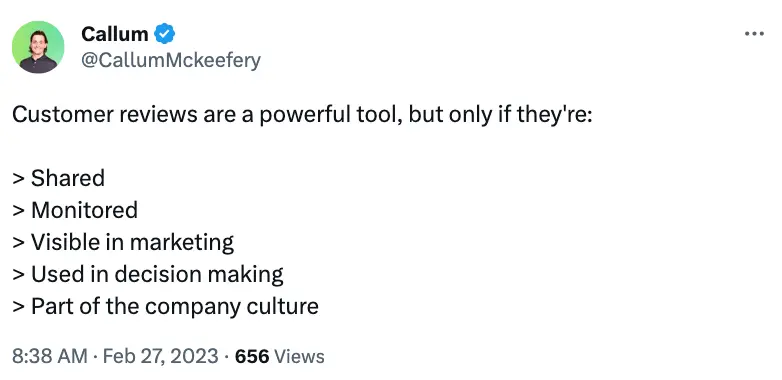
You don’t need to be everywhere as a brand, so read the following customer review use cases as options rather than obligations. Wherever you are already, though, your customers should also be with you.
Case studies for bottom-of-funnel content marketing
If you’re B2B, one of the best things you can do with a glowing customer review is to expand it for a case study.
Case studies are amplified, detailed, and highly valuable versions of customer reviews. You’ll want to have strong relationships with your most loyal customers so you feel comfortable asking them for a case study.
Whether your primary review source is G2, TrustRadius, or social media channels, start by pulling out your most positive reviews and examining their associated customer profile. If their profile shows many purchases or a lot of activity, that may be a sign you can reach out to them for a case study.
Great case studies are a combination of high-quality anecdotes that address pain points and quantitative data points that demonstrate impact. This Klaviyo case study shows how you can pull in readers with an impact-focused headline and a glowing review.

The case study itself is your chance to tease out that positive review, so readers understand why your product is deserving of it. And when you devote resources to building up a whole library of case studies, you’ll eventually have a repertoire of stories that address every possible pain point your product addresses.
Email marketing
One of the main benefits of including customer reviews in your marketing emails is that they can increase your click-through rates.
In addition to social proof, customer reviews create curiosity and relevance. When placed in close proximity to an effective CTA, reviews are the positive nudge some recipients need to click—especially if the review has been well-matched to their needs as a potential customer.
Here are 3 email automations that can benefit from customer reviews:
1. Welcome series
Your welcome emails go out to new subscribers after they join your email list. They introduce new people to your brand and warm them toward an eventual purchase.
While some brands might choose to introduce themselves to subscribers in their own words, other brands might opt to tell that story with customer reviews—like in this simple, beautiful example from Furtuna Skin, which features great design, customer photos, and strong review copy from industry folks who have clout.

2. Abandoned cart emails
Abandoned cart emails reel potential buyers back into the purchase process after they’ve placed an item in their cart but didn’t complete an order. While some brands rely on discounts to nudge people toward a sale, this isn’t always feasible for brands with a smaller budget.
Remember that whole concept of “perceived brand value”? Your abandoned cart emails are a perfect testing ground for customer reviews. When you’d rather show why someone should complete their purchase, reviews are a great way to demonstrate value.
This example from Casper includes two CTAs: one to pick up the purchase, and a back-up to read more reviews like the one included. The inclusion of the review respects the mindset of the customer that needs to do more research before deciding to purchase.
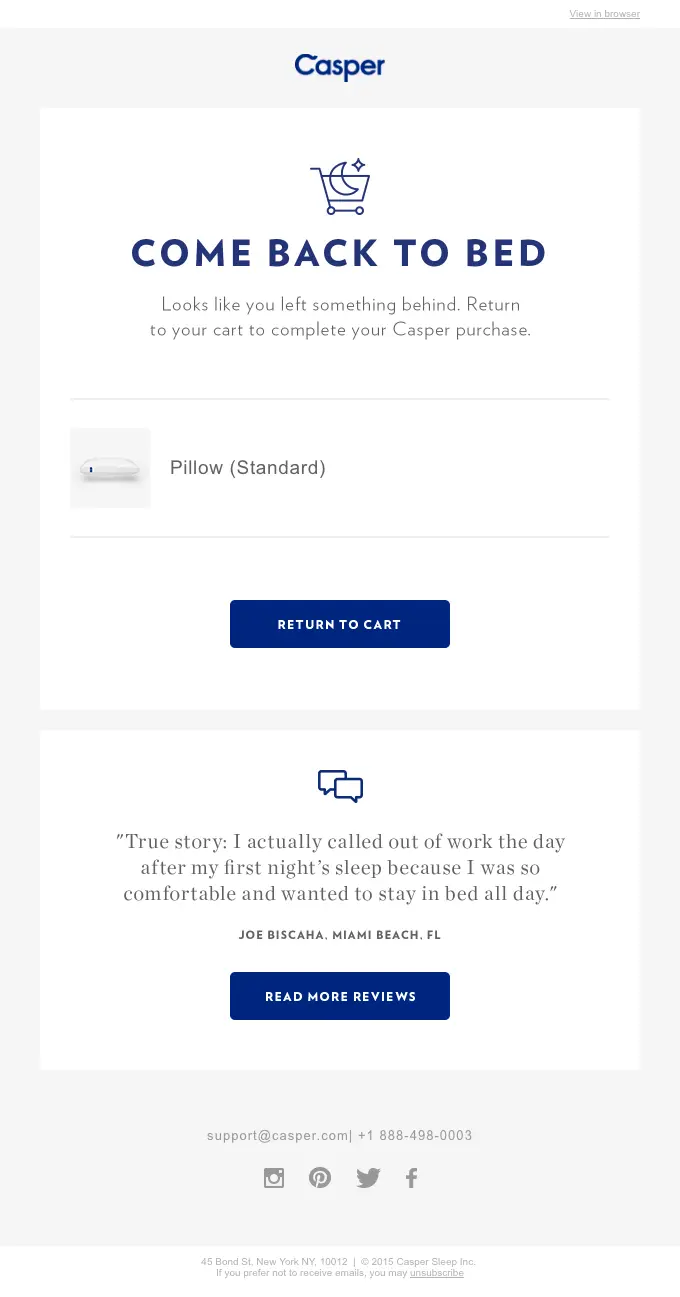
3. Post-purchase emails
Post-purchase emails fall into several categories:
- Transactional: shipping, order confirmations, etc.
- Educational: product maintenance and use
- Promotional: retention and loyalty.
Social proof isn’t only great for finalizing purchase decisions—it’s also great for confirming that the decisions your customers already made were good ones. This reinforcement mechanism can lead to future purchases and long-term customer loyalty.
In this example, MeUndies grabs customer reviews from Twitter to encourage people to follow their social media profiles after a purchase.

Notice how the ask becomes all the more relevant because the reviews came from social media platform. It’s a low-investment way to encourage customers to “join a community” on the channels where they’re already hanging out.
Plus, it keeps the purchaser as close to the brand as possible after a purchase, so they’re more likely to act again on an offer that’s relevant for them.
Paid advertising
When we talk about paid ads for ecommerce, we’re typically referring to:
- Google ads (including Google Shopping ads)
- Social media ads, like Facebook ads
- Remarketing ads
- Influencer marketing
- Affiliate marketing
Check out this Facebook Ads example from Leonisa, which includes a video and quote from a customer as ad copy. Note that the copy is unedited and that it reads like copy you’d find on social media—Leonisa has rightfully resisted the urge to “clean up the copy,” choosing instead to showcase the actual words of the customer.

Here’s another example from Google Seller Ratings—a Google Ads extension that pulls up a star rating for your brand as a top result when people search for you. The rating is calculated by aggregating customer reviews from sources Google trusts.

To qualify for seller ratings, you need:
- An average rating of 3.5 or more stars for text ads
- A Google search ad whose visible URL domain matches the domain for which Google has the ratings
Also note that the reviews from customers within a given country only contribute to your rating in that country, not in others.
Video marketing
According to Think with Google, more than half of shoppers say online videos help them decide which brand or product to buy.
McKinsey confirms the same trend: 57% of consumers say YouTube influenced their holiday buying decisions in 2021. If you isolate the data to Gen Z shoppers, that number increases to 87% (with Instagram and TikTok as added sources).
Video marketing is all the more powerful when the content feels like case studies. Some brands produce video case studies themselves, but others choose to leverage the videos customers create instead.
Check out this example about Cubby, maker of safety beds for people with autism, cerebral palsy, down syndrome, and other special needs.
The video wasn’t made by Cubby at all—it was made by a Cubby customer who also happens to be a micro-influencer on YouTube. If Cubby were to leverage this video further, instead of investing budget in video production, they could partner with this creator to feature the video elsewhere.
Website and search ranking
Last but not least, the most important channel for customer reviews is your own website.
“Especially in the modern world of influencers and Instagram filters, including UGC throughout your website adds a layer of authenticity that helps validate any concerns shoppers may have about purchasing your products,” Kolinsky says.
Including UGC throughout your website adds a layer of authenticity that helps validate any concerns shoppers may have about purchasing your products.
When people shop, one of the first things they check on product description pages are reviews—and you need to show a lot of them to instill trust that any accompanying ratings are valid.
Here are two primary ways customer reviews can make your website more effective at selling products.
1. Homepage reviews
One of the most important introductions to your brand is your website—and who better to introduce you than your customers?
Customer reviews enhance your website’s overall user experience by offering relevant information upfront. Not only that, but reviews can also benefit your SEO efforts as a constant source of fresh, relevant content, which signals to search engines that your website is updated often.
If you’re a new-ish brand without a ton of reviews for some of your products, homepage reviews can help compensate. Check out this example from Cargo Crew, which features reviews on their homepage under product listings that don’t yet have star ratings or reviews.
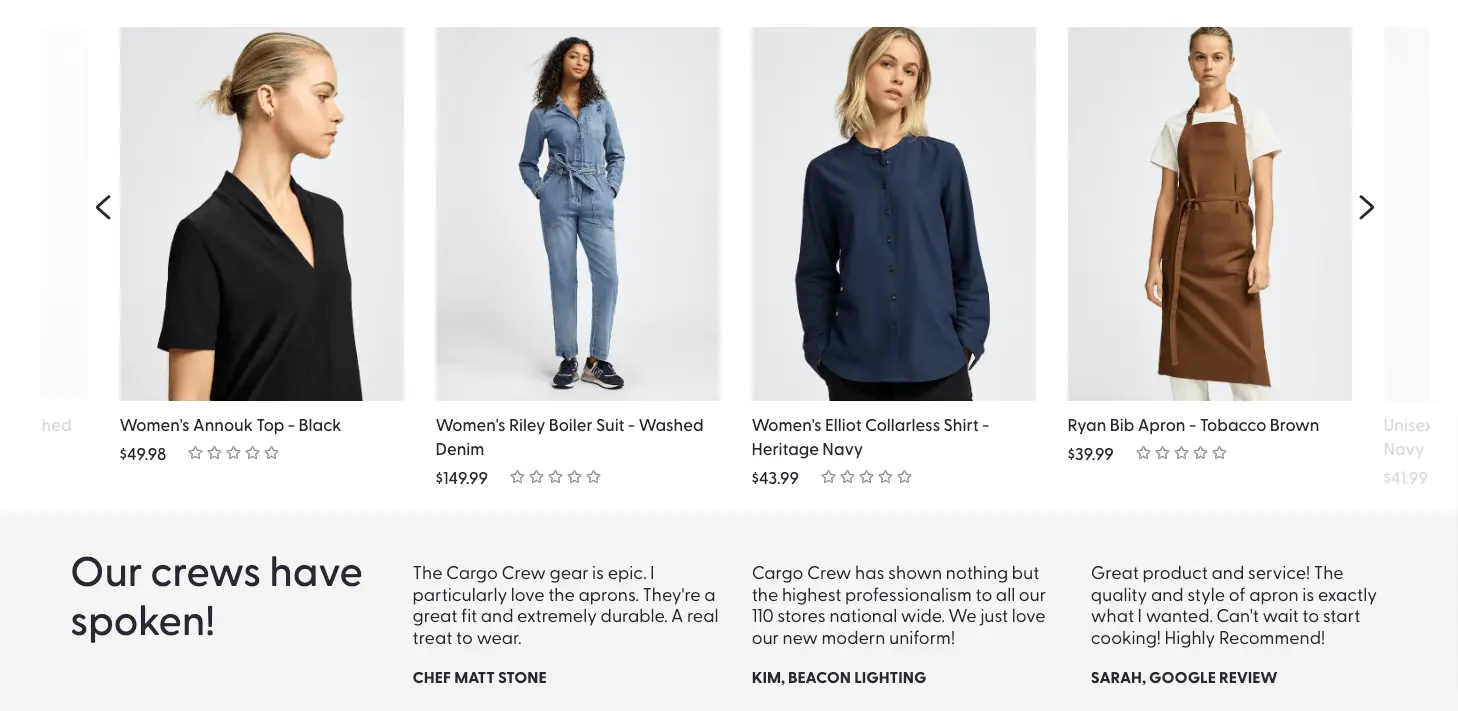
2. Product description page reviews
Product description page reviews are the bread and butter of ecommerce.
When a customer lands on a product page, one of the first things they check out are the reviews. Better than your own descriptions, reviews address common questions, concerns, and objections, so customers can make more confident purchase decisions. Bonus if reviews run a’plenty and are accompanied by a star rating that represents the average review.
Check out this example from Nuun—a brand that clearly understands the assignment. For their Recover product, they include a star rating under the product title with the number of reviews available. When a customer wants to read reviews, they just click on the number to find all reviews.

The importance of review request automation
Requesting reviews from customers is a lot of work. Considering the importance of recency and relevance for customer review credibility, you could probably devote a full-time job to requesting reviews alone.
Or, you could automate the process.
There are review platforms that automate review requests based on real-time shipment tracking, so you’re catching people at a time when they’re most likely to review. And all the data gathered from reviews—product ratings, user-generated content, etc.—show up on the customer’s profile, so you can use the information to further personalize the experience for that customer.
As Lindsey Arellano, director of email and SMS at CURIO, puts it, “by timing your review requests correctly, you can increase the likelihood of receiving positive reviews and improve your online reputation.”
Customer review marketing FAQs
Do I need permission to use reviews in marketing material?
Yes, you need permission from customers to use their reviews in marketing materials. Consent ensures compliance with privacy and advertising regulations, such as the General Data Protection Regulation (GDPR) in Europe and the California Consumer Privacy Act (CCPA) in the US.
How do customer reviews improve sales?
Customer reviews improve sales by building trust and credibility with potential customers. They provide “social proof” that the product is of good quality. When you build trust with reviews from actual customers, more people are likely to buy the product based on what they view as a personal recommendation.
Which is the best marketing channel to use customer reviews on?
The best digital marketing channel for customer reviews depends on where a brand’s audience is most likely to see them, but the most obvious is product description pages, where consumers can read reviews as they shop for products.

Related content

Discover how leading brands use Klaviyo to grow subscription businesses. Learn strategies for upselling, personalization, retention flows, and advanced automations that increase lifetime value and reduce churn.

New research shows brands that retain fewer customers—but increase those customers’ spend—are growing at more than 3x the rate of brands that retained more but failed to increase spend.

With potential tariffs creating uncertainty and threatening profit margins, here are 3 ways marketers can use Klaviyo to stay resilient and protect profits in any economy.